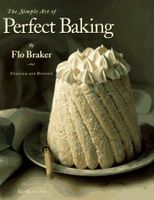Advertisement
Preparation info
- Makes
2 ½ pounds
- Difficulty
Medium
Appears in
By Flo Braker
Published 1984
After baking, this puff pastry rises three or four times its original thickness and becomes crisp and brittle.
Ingredients
Dough Package
Method
Advance Preparation
At least 12 hours before making the puff pastry, prepare the dough package either by hand or machine as directed below.
Hand Method
Making the Dough Package
Pour the flours into a triple sifter and sift into a mound on work surface. Reserve


